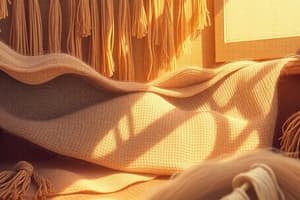Podcast
Questions and Answers
Which of the following is NOT a natural fiber?
Which of the following is NOT a natural fiber?
- Wool
- Silk
- Cotton
- Nylon (correct)
What is a key characteristic of synthetic fibers?
What is a key characteristic of synthetic fibers?
- They are produced from chemical processes. (correct)
- They are derived from natural sources.
- They require no processing for use.
- They are always biodegradable.
Which process involves interlacing threads to create fabric?
Which process involves interlacing threads to create fabric?
- Tufting
- Filament extrusion
- Woven fabrication (correct)
- Knitting
Which property of fabrics is most associated with breathability?
Which property of fabrics is most associated with breathability?
What is the primary application of cotton in the fashion industry?
What is the primary application of cotton in the fashion industry?
Which of the following fibers is considered a manmade fiber?
Which of the following fibers is considered a manmade fiber?
Which type of fiber is known for its luxurious feel and is often used in high-end fashion?
Which type of fiber is known for its luxurious feel and is often used in high-end fashion?
What is one of the defining characteristics of fabrics created through the knitting process?
What is one of the defining characteristics of fabrics created through the knitting process?
Which of the following is an example of a natural fibre?
Which of the following is an example of a natural fibre?
What is one main advantage of synthetic fibres compared to natural fibres?
What is one main advantage of synthetic fibres compared to natural fibres?
Which two types of animal-based fibres are commonly used in clothing?
Which two types of animal-based fibres are commonly used in clothing?
What is the basic process of transforming fibres into fabric?
What is the basic process of transforming fibres into fabric?
Which fabric property primarily affects its use in clothing for varying temperatures?
Which fabric property primarily affects its use in clothing for varying temperatures?
What sets knitted fabric apart from woven fabric?
What sets knitted fabric apart from woven fabric?
Why might polyester be preferred for outdoor clothing?
Why might polyester be preferred for outdoor clothing?
Which synthetic fibre is often used as a substitute for wool?
Which synthetic fibre is often used as a substitute for wool?
Flashcards are hidden until you start studying
Study Notes
Introduction to Fibres and Fabrics
- Fibres are thin, thread-like structures that form fabric.
- Fabric is created by weaving or knitting long fibres together.
- There are two main types of fibres: natural and synthetic.
- Natural fibres come from plants and animals.
- Synthetic fibres are man-made from chemicals.
Natural Fibres
- Plant-based fibres:
- Cotton: Soft, breathable, and used in clothing.
- Linen: Made from flax, strong and durable, used for clothes, tablecloths, etc..
- Hemp: Used for clothing and rope.
- Jute: Used for rope and bags.
- Coir: Used for doormats and ropes.
- Animal-based fibres:
- Wool: From sheep, keeps warmth, often used in winter clothing.
- Silk: From silkworms, soft, shiny, luxurious fabric, often used in high-end clothing.
Synthetic Fibres
- Polyester: Strong, durable fabric made from petroleum, often used in sportswear and everyday clothing.
- Nylon: Lightweight, strong, used for stockings, sportswear, and ropes.
- Acrylic: Used as a substitute for wool, soft and lightweight, commonly used in sweaters and blankets.
Advantages of Synthetic Fibres
- Strong
- Durable
- Less expensive than natural fibres
Disadvantages of Synthetic Fibres
- Not as breathable as natural fibres
- May feel less comfortable
Fabric Production Process
- Fibres are spun into yarn.
- Yarn is woven or knitted to make fabric.
- Weaving interlaces yarns to form fabric (e.g., shirts, pants).
- Knitting loops yarns together to create stretchy fabric (e.g., sweaters).
Properties of Fabrics
- Breathability: Allows air to pass through (Cotton is more breathable than polyester).
- Water absorption: Natural fibres like cotton absorb more water, while synthetic fibres repel water.
- Durability: Synthetic fibres tend to be more durable than natural fibres.
Studying That Suits You
Use AI to generate personalized quizzes and flashcards to suit your learning preferences.




